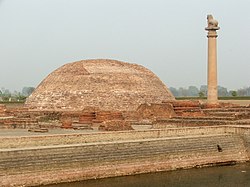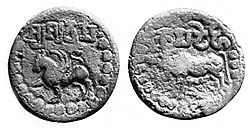Licchavi
Licchavi were a clan in northern India who had their capital at the city of Vaishali during the lifetime of Gautama Buddha.[1] The period of Licchavi rule around the city of Vaishila is known as the Licchavi Republic.[2]
The Licchavi are mentioned in a number of discourses in the Pali canon, such as the Licchavi Sutta[3] and the Mahālisutta,[4] as well as a commentary on the Ratana Sutta.[5]
In the Mahayana Vimalakirti Sutra, the bodhisattva Vimalakirti was a Licchavi from Vaishali.[6]
A branch of the Licchavi clan conquered the Kathmandu Valley (in modern-day Nepal) and ruled over area from approximately 400 to 750 CE.[7][8][9] The period of Licchavi rule is referred to as the Licchavi Kingdom of Nepal.
In approximately 632, Princess Bhrikuti of the Licchavi Kingdom of Nepal married King Songtsen Gampo of Tibet.
- Further reading
 Definitions for licchavī, SuttaCentral
Definitions for licchavī, SuttaCentral Licchavi (tribe), Wikipedia
Licchavi (tribe), Wikipedia Licchavi (kingdom), Wikipedia
Licchavi (kingdom), Wikipedia
Notes
- ↑ Robert E. Buswell Jr., Donald S. Lopez Jr., The Princeton Dictionary of Buddhism (Princeton: 2014), s.v. Vaiśālī
- ↑
 Licchavi (tribe), Wikipedia
Licchavi (tribe), Wikipedia
- ↑ "Licchavi Sutta," translated from the Pali by Thanissaro Bhikkhu (2004).
- ↑ Robert E. Buswell Jr., Donald S. Lopez Jr., The Princeton Dictionary of Buddhism (Princeton: 2014), s.v. Mahālisutta
- ↑ "Ratana Sutta: The Jewel Discourse," translated from the Pali by Piyadassi Thera (1999).
- ↑ Thurman, Robert. "Vimalakirti Nirdesa Sutra". Retrieved 17 September 2014.
- ↑ Kaplan, Robert B.; Baldauf, Richard B. (2008). Language Planning and Policy in Asia: Japan, Nepal, Taiwan and Chinese characters. Multilingual Matters. ISBN 978-1-84769-095-1.
- ↑ Asiatic Society (Kolkata India) (1902). Journal of the Asiatic Society of Bengal. Asiatic Society of Bengal.
- ↑ Journal of the Asiatic Society. 1902.

